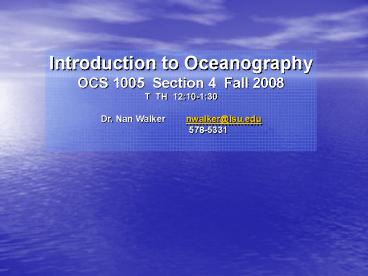Introduction to Oceanography - PowerPoint PPT Presentation
1 / 36
Title: Introduction to Oceanography
1
Introduction to Oceanography OCS 1005 Section 4
Fall 2008 T TH 1210-130 Dr. Nan Walker
nwalker_at_lsu.edu 578-5331
2
Text Oceanography An Invitation to Marine
Science 6th Edition by Tom
Garrison Internet text available in 4-5 days,
free shipping Kellie Debroeck from Thomson
Publishing
3
What is Oceanography ??
- Study of the earths oceans including coastal
waters - Geological, physical, chemical, and biological
systems - Processes, linkages, interactions, feedbacks
4
Geological Oceanography His
tory of Sediments and Ocean basins Fossil
records Coastline change/ beaches/
deltas Resources oil/gas/minerals
5
- Chemical Oceanography
- Dissolved solids and gases
- Salinity
- Nutrients
- Climate change
- Greenhouse gases- CO2
- Carbon cycling
6
- Physical Oceanography and Meteorology
- Waves
- Tides
- Currents
- Air-sea interactions
- Climate
- Numerical Modeling
- circulation
- climate change
7
Biological Oceanography Plankton,
Algae Fisheries Marine Mammals Marine
Communities Coral Reefs
8
Syllabus
9
(No Transcript)
10
Special Topics and MOVIES
- Global change/climate change
- Is global warming effecting hurricane intensity?
- El Nino Southern Oscillation
- Louisiana Land Loss
- Coral Reefs the state of Caribbean reefs
- Deep sea marine life- giant squid
- Whales and dolphins
- Harmful algal blooms
- Hypoxia/Anoxia in northern Gulf of Mexico
- History of Earth and Crude Oil formation
11
Class Rules Please respect your fellow student
and teacher. Turn off cell phones, arrive on
time, alert me for early departures. Laptops for
note taking only. Class Attendance is IMPORTANT
for success in this class. Attendance will be
taken and may make a difference in your
grade. One question quizzes count for 10 of
grade. Makeup exams contact me within 24 hours
of exam makeup will be harder than 1st test
doctors written excuse required Points taken
off if excuse not acceptable. Exam schedule is
firm unless university is closed then next
class after opening will be the exam. Read
Code of Student Conduct Office of the Dean of
Students
12
Grading Expect the Tests to be difficult!
Form study groups Four Tests
90 Quizzes/assignments in class
10 Optional bonus research paper
10
13
Grading Scale A 90 -100 B 80 89 C 70
79 D 60 69 F 0 59
14
My academic and ocean experiences. B.S. Marine
Biology, Duke University, 1976 Sea
Education Association, seamanship and
oceanography (North Atlantic, Caribbean
Sea, Gulf of Mexico) M.S. Marine Sciences, LSU,
1982 Satellite oceanography and
Air-sea interactions during winter storms Ph.D.
Physical Oceanography, University of Cape Town,
1989 Ocean climatology influence of
ocean on weather/rainfall Ocean crossings
South Atlantic, Caribbean Sea, Gulf of Mexico
6 months at West Indies Marine Laboratory LSU
Faculty, Dept. Oceanography and Coastal Sciences
and the Coastal Studies Institute,
1991-present Director of Earth Scan Lab, Coastal
Studies Institute, LSU since 2003
15
South Atlantic Ocean September 1989
16
Earth Scan Laboratory http//www.esl.lsu.edu
17
What experiences have you had with the ocean?
For Monday One paragraph summarizing what in
syllabus you have already been exposed to in
school.
18
You and I affect the Ocean! Farmers
in the midwest affect fishing in the Gulf of
Mexico!
19
Utilization of the Ocean
- Transportation
- Natural resources (food, mineral, oil, gas,
energy)- 30 of oil and gas - High concentration of human population in the
coastal region- doubled in last 40 years, 50 of
humans on coast - Disposal of Pollutants/Garbage
- Military Naval power
20
Earth Blue Planet. 71 of the Earth is covered
by water
21
An Ocean World is very unique!
- Water as a liquid in large quantities
- Moderates temperatures
- Hospitable atmosphere
22
Oceans role in Weather and Climate Change
(mostly invisible)
- Ocean covers 71 of the earths surface.
- Heat capacity (ability to store heat) of water is
much larger than that of land or atmosphere - Heat stored in 1 m of waterheat of 15 km of
atmospheric water vapor - Dominant role of ocean-atmosphere interaction in
regulating the earths weather and climate - (Hurricanes / El Nino)
23
Salt Water is required for any life form
All life, from a jellyfish to a desert
weed, depends on saline water within its cells to
dissolve and transport chemicals!
24
The distribution of land and ocean in the
Northern and Southern Hemispheres
differ. What are consequences to weather and
climate?
60
80
25
Characteristics of the World Ocean
- Average depth 3,796 m (12,451 feet)
- (Average land elevation 840m (2,772 feet)
- Deepest spot Mariana Trench 11,022m (36,163
feet) - (Highest spot on land Mt. Everest 8848m
(29,028 ft) - Average temperature 3.9oC (39oF)
- Average percent of salt 3.4
- salinity 34 ppt
26
WATER SUMMARY where is it?
- 97.5 in ocean (saline)
- 2.5 fresh
- 1.7 in ice on land
- 0.8 in groundwater
- 0.007 in rivers and lakes
- 0.001 in the atmosphere
27
The World Ocean
28
OCEAN Basins
- Southern
- Pacific
- Atlantic
- Indian
29
Mediterranean Seas
- Large
- Restricted Connection
- Deep Basin
30
Mediterranean Seas Epicontinental Seas
Greenland Sea
Bering Sea
Mediterranean
Sea of Okhotsk
Sea of Japan
Gulf of Mexico Caribbean Sea
East China Sea
Red Sea
South China Sea
31
32
Regional Ocean Currents
Equatorial current Yucatan Current Loop
Current Florida Current Gulf Stream
North Atlantic gyre
GOES satellite image showing ocean temperature
Winter Sea Surface Temperatures
33
Depths of Florida Straits controls the depth
of the Loop Current
Max 3900 m
1000m
2000m
34
The Gulf of Mexico Loop Current and warm
eddy shedding
35
LSU Earth Scan Lab http//www.esl.lsu.edu
36
- Homework for Monday
- Buy textbook, read chapter 1
- Check Moodle for lecture 1 file
- One paragraph summarizing what in syllabus
- you have already been exposed to in school.
- Bring on Monday, Counts 1 point towards grade!
- Find digital picture of yourself and post to
Moodle - Counts 1 point towards grade!































